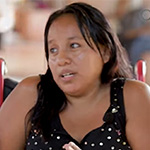Darlin Elvir Gonzalez, a resident of Comayagua, Honduras, was never able to attend school due to a lack of accessible infrastructure for persons with disabilities. Despite missing out on formal education, she is pleased that the newly reconstructed Marcelino Pineda Elementary School, which her son attends, has included accessible features, such as ramps.

A group of children, teachers and their parents greet to the camera in the entrance of a school in Ojojona, Honduras.
Source: Global Facility for Disaster Reduction and Recovery at the World Bank
I was sad before because I was unable to enter the school. I always had to leave my child outside because I could not go up the stairs. But now I am happy. The school is beautiful, and now I can access it.

However, many persons with disabilities in Honduras continue to grapple with exclusion, marginalization, and limited access to essential services, particularly education. According to a World Bank Disability Inclusion report on Latin America and the Caribbean, almost seven in ten households with persons with disabilities are vulnerable to poverty. On average, school-age children (6-12 years old) with disabilities represent a significant share of the out-of-school population, accounting for one in five children. Furthermore, illiteracy is five times higher among persons with disabilities (22.1 percent versus 4.3 percent).
The causes are complex but inaccessible environments are a major barrier for both students and parents. This vulnerability is further exacerbated during disasters, where the lack of preparation and inaccessible facilities lead to the disproportionate exclusion of persons with disabilities.
As Honduras is country highly exposed to natural hazards and has experienced devastating shocks to its population and economy, rebuilding after disasters with an eye to both ensuring resilience and inclusion is key. In November 2020, the country was struck by two consecutive tropical storms, Eta and Iota, affecting approximately 4.5 million people, with losses and damages amounting to almost USD 1.9 billion.
Responding to this crisis, the Honduran Government, with the support of the World Bank, initiated a project focused on rebuilding critical infrastructure, including schools, health facilities, water and sanitation works, and roads and bridges. With a significant emphasis on the education sector, this project aims to enhance disaster and climate resilience and provide universal access in reconstructed schools.
To ensure student safety, all schools undergo assessments for disaster risks such as flooding, landslide, and/or earthquake risks. Structural interventions are carried out to mitigate these risks, with measures including raising school heights, securing roofing, undertaking soil evaluations for seismic risk, and/or including small-scale risk mitigation measures, such as improved drainage. Moreover, schools integrate bioclimatic designs to address the impacts of climate change, with adjustments to roofing, window placement, and ventilation to cope with extreme weather conditions.

This school in Comayagua now counts on greater accessibilidty thanks to its new ramps. Source: The World Bank
In addition, schools incorporate universal design principles, wherever possible, which means designing infrastructure or services that are usable by all people, to the greatest extent possible, without the need for adaptation. Ramps, railings, and accessible toilets are included to ensure not only safer but also more inclusive educational settings. These benefits extend beyond the educational sphere as many schools double as shelters during disasters, guaranteeing a safe place for all citizens in future emergencies.
The success in promoting inclusivity and risk-informed design in the project can be attributed to two factors. First, a participatory and consultative process has been central to project design. Workshops with local communities, parents, and teachers gather inputs on needs which are then incorporated into the designs. Collaboration with civil society organizations, such as the Federación Nacional de Padres de Personas con Discapacidad de Honduras (FENAPAPEDISH), also strengthens efforts to meet the needs of persons with disabilities. Second, technical advice from the World Bank and the Global Facility for Disaster Reduction and Recovery (GFDRR) has guided the incorporation of resilient infrastructure and universal design concepts in the project.
While inclusive and accessible approaches require more work and can be more costly to design, long-term benefits outweigh these costs. A World Bank study highlights that accessible facilities increase building costs by an estimated 0.5 to 1 percent if they are planned, designed, and implemented from the onset, whereas retrofitting after completion can cost 5 percent or more of initial construction costs. Moreover, these investments contribute to more inclusive societies, benefiting a broad spectrum of people including those with temporary disability, the elderly, pregnant women, children, and persons with obesity.
